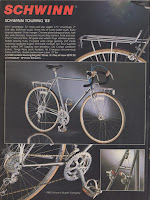Friday was the first day of summer break for my kids. I'm a full-time teacher, so it's summer break for me, too.
We spent our first day of break doing something we love to do - riding our bikes on the Ohio & Erie Canal Towpath in the Cuyahoga Valley National Park.
We took my early '80s Specialized Stumpjumper with the double Trail-A-Bike tagalong trailer, which makes it easy for us to stay together. That Stumpjumper is a truck, let me tell you. Altogether with the Trail-A-Bike attached, the thing is a family train and gets a lot of second looks and comments.
Our ride began at a spot called the Botzum Trailhead, just on the edge of Akron, and I thought we were just going to ride a few miles north to Szlay's Fruit Market -- a popular stop along the path. Friday was not only the first day of summer break, but it was also opening day at the market. Once we got going, the Retro-kids decided they wanted to ride all the way to Deep Lock, which is just outside the village of Peninsula, right in the heart of the national park, and easily twice as far away.
On the way to Peninsula, we crossed over a boardwalk that bridges a beaver marsh. I've never actually seen a beaver there, but one can see their dens, dams, and other handiwork. On the boardwalk, the kids like to stop and look for fish, birds, and other wildlife. Blue herons are a common sight, as are ducks, geese, painted turtles, carp, and bluegill.
 |
| The Retro-kids spot a snapping turtle in the marsh. |
 |
| And there's the turtle. His shell is probably about 15 inches across. |
After that stop, we continued on our way to Deep Lock. On the way, this happens:
Retro-kid: "Dad, I think we need to stop."
Retrogrouch: "What's wrong."
Retro-kid: "Something broke."
We stop, and I see that the plastic Shimano shift lever on the Trail-A-Bike has basically exploded. The main screw that holds the mechanism together fell out the bottom somewhere on the trail. We walked around a bit looking at the ground, but seriously, it could have been anywhere.
I decided that it was only another mile or so from Deep Lock to Peninsula where there is a bike shop. I picked up what shifter pieces we had, and we rode on to the village for a visit to Century Cycles. It didn't seem critical that the kids would need to shift for a few miles. I figured it was a long shot that the shop would have the right screw to put the lever back together, but we lucked out. A little searching in the bins turned up one that fit. Fantastic. Back down the trail.
At 17 feet, Lock 28 North, or Deep Lock, is the deepest (as the name implies) of the locks on the old canal. It is situated about a mile south of Peninsula. The girls like to run around it looking for frogs.
 |
| Frog-spotting. |
 |
| Showing off the cycling gloves they talked me into buying them at the bike shop. |
 |
| There's the family train, in front of Lock 28 North - aka Deep Lock. |
After visiting the lock, it was time to start heading back south. Next stop, Szlay's fruit market. By this time, though, the kids were starting to tire a bit of the saddles. For the next couple of miles, I kept hearing this from the younger Retro-kid:
"Are we there yet? I can't feel my butt!"
The familiar red rooftops of Szlay's barn and fruit market soon appeared. The market is a great oasis on a bike ride in the CVNP. Weekends, especially, are great, as they have soft-serve ice cream, hot dogs, roasted sweet corn, and other treats in addition to the usual selection of awesome produce. We stopped for a treat and sat on a gliding bench/table.
 |
| The Retro-kids enjoy cold treats at Szlay's. |
 |
| Playing on the old-time farm tractor. The Cuyahoga Valley Scenic Railroad train can just be seen passing by in the background. |
Well rested, we started back to the Botzum trailhead. Suddenly we spotted an unexpected surprise sunning itself in the trail. Another snapping turtle.
 |
| One of the girls was afraid to get too close. The other got close enough for a picture. |
When we got back to the trailhead, the kids heaved a huge sigh of relief. They had a good time, but the 13 or so miles was a long ride for them. Not so much for me, though it's quite a workout towing them behind me.
First day of summer break - and the start of another nice summer of riding memories with the Retro-kids.








































